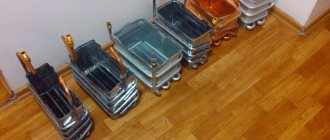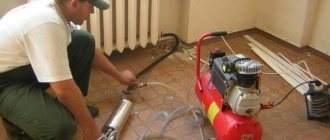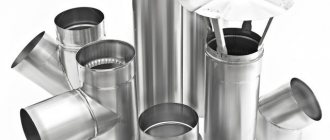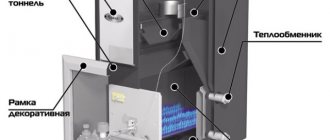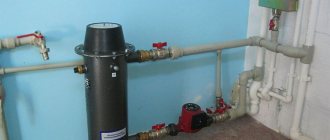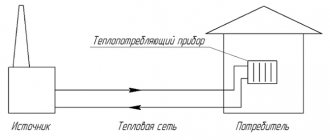During the process of construction, repair or modernization of heating, ventilation and hot water supply systems, many have to deal with this type of equipment as heat exchangers. In order to choose the right device and buy a plate heat exchanger in St. Petersburg with optimal characteristics, you need to have a basic understanding of the operating principles and main parameters of this equipment.
A heat exchanger is an installation in which the working unit carries out heat exchange between media of different temperatures. The media (coolant and heat consumer) are separated by thin walls of pipes or plates, if we are talking about a plate heat exchanger (PH). By changing the heat exchange area, the amount of thermal energy that the heating medium transfers to the heated medium changes.
The scope of application of heat exchangers is extremely wide: they are used in heating systems, hot water supply, and in the installation of cooling and heating systems for swimming pools. With the help of these installations, engineers are able to implement effective modern solutions not only at large enterprises, but also in multi-storey residential buildings, private cottages and apartments. In industry, this equipment is widely used in mechanical engineering, food production, and the pharmaceutical industry.
Knowing the basic characteristics and principles of selecting heat exchange units, you can ensure high operating efficiency of this equipment and avoid unnecessary costs. If you have any doubts about your choice, then the right decision would be to get advice from specialists from the company supplying this equipment, for example, the managers of Service-PTO LLC. They will not only perform the necessary calculations and select the appropriate equipment, but will also provide information and service support during operation.
Definition of the task
The first stage in selecting a heat exchanger is identifying the problems that need to be solved with its help. Since the main function of a heat exchanger is to transfer heat from one medium to another, you need to decide what needs to be done - heat or cool the working medium. It is also important to know where the heat exchanger will be installed - for example, a heat exchanger is required for a swimming pool, installation of a hot water system in a cottage, a heating system, ventilation system or for other technological processes. Having decided on the purpose and location, you can begin to select the main characteristics of this equipment.
If you are selecting a heat exchanger for a DHW system, you need to decide on the number of mixers and the required supply temperature (including the possibility of switching to “summer” operating mode) and the flow rate of liquids that need to be heated or cooled. When using a heat exchanger for refrigeration, you will need to know the operating temperatures in order to correctly calculate the equipment's power in advance. When installing a ventilation system and heating system, you will also need to know the power of the system and the temperature of the coolant supply.
Types of heat exchangers for hot water systems
Today there are many of them, but among all, the two most popular for everyday use are shell-and-tube and plate-type systems. It should be noted that shell and tube systems have almost disappeared from the markets due to low efficiency and large sizes.
A plate-type heat exchanger for hot water supply consists of several corrugated plates located on a rigid frame. They are identical to each other in design and dimensions, however they follow each other, but according to the principle of mirror reflection, and are divided among themselves by specialized gaskets. Gaskets can be either steel or rubber.
Due to the alternation of plates in pairs, cavities appear that during operation are filled with either heating liquid or a heat carrier. It is due to this design and operating principle that the displacement of media between themselves is completely eliminated.
Through the guide channels, the liquids in the heat exchanger move towards each other, filling the even-numbered cavities, and then exit the structure, receiving or giving up some of the heat energy.

Scheme and principle of operation of a hot water supply plate heat exchanger
The more plates in number and size there are in one heat exchanger, the larger the area it can cover, and the greater its productivity and useful effect during operation will be.
For some models, there is space on the direction beam between the locking plate and the frame. It is enough to install a couple of slabs of the same type and size. In this case, the tiles installed additionally will be installed in pairs.
All plate-type heat exchangers can be divided into several categories:
- 1. Soldered, that is, non-separable and having a sealed main body.
- 2. Collapsible, that is, consisting of several individual tiles.

The main advantage and plus of working with collapsible structures is that they can be modified, modernized and improved, from removing unnecessary ones or adding new plates. As for soldered designs, they do not have such a function.
However, plate-brazed heat supply systems are more popular today, and their popularity is based on the absence of clamping elements. Thanks to this, they are distinguished by compact sizes, which do not in any way affect their usefulness and performance.
Methods for selecting a heat exchanger
There are several options for selecting a heat exchanger:
- Independent calculation of the necessary parameters using formulas. Having a specialized education, it is possible to cope with this task, but then you will have to choose one of several suitable models from different manufacturers and with different prices. Without thoroughly knowing the market for this equipment, you can easily make a mistake, purchase inexpensive but low-quality equipment, or overpay for unnecessary options.
- Selection by professional engineers using special software. This approach allows you to avoid mistakes, since the specialist takes into account budget wishes and all input data: dimensions of the installation site, required power, temperature conditions, etc. Engineers select not only a heat exchanger, but also a full set of consumables for installation. Most specialized ones carry out calculations and selection of heat exchangers for free.
What factors does effectiveness depend on?
Several factors influence performance:
- Device design.
- Operating mode, temperature of the releasing coolant.
- The amount of heat loss or, more simply, the condition of the inner surface of the tubes (the absence of scale or deposits that act as a heat insulator and reduce the ability to receive or release thermal energy).
Since the device is selected at the design and installation stage, and the operating mode is set when setting up the heating system as a whole, the most important factor is the fight against losses. To do this, the household heat exchanger is periodically washed and cleaned using various means.
, of which there are plenty on sale.
Acid compounds are used to remove scale, and fatty deposits are cleaned with caustic soda. After cleaning, the device is thoroughly washed and reconnected to the equipment. Another means of prevention and reduction of pollution are filters. With their help, foreign particles, suspension, and fatty compounds are eliminated. At the same time, filters also need to be periodically washed or replaced.
Required characteristics
The parameters and required characteristics depend on the type of heat exchanger. Surface heat exchangers are most often used: there is no mixing of media in them. Among them, regenerative and recuperative installations are distinguished (depending on the direction of coolant flow).
Also, depending on the design features, heat exchangers with a flat surface (plate heat exchangers, spiral) and tubular (shell and tube, coil, “pipe in pipe”) are distinguished.
The key characteristics of the heat exchanger, regardless of its type, are:
- Operating pressure and coolant temperature. The higher these parameters, the higher the price of the equipment.
- Heat transfer surface area.
- Required heat exchanger power. If we are talking about a plate heat exchanger, then the required number of plates is selected depending on the power.
- Consumption of coolant and working medium.
Data for calculation
To select a heat exchanger you need to know:
- Power of the heat exchange process. If it is unknown, then for the DHW system it is necessary to determine the number of water intake points (mixers), for the heating system - the area of the heated premises.
- Heat source. This could be a thermal power plant, a boiler room, or a central heating point.
- Maximum operating t, temperature graphs of the heat source and consumer system.
- DHW connection diagram.
- Type of medium: information about the heating and heated medium (t at the inlet and outlet, pressure loss and medium flow). For a heated environment, you also need to know the percentage of power reserve.
- Consumption of working medium. You need to know how much of the working medium passes through the heat exchange installation over a certain time interval. To calculate this parameter, the density of the medium is multiplied by its volume.
- Allowable pressure losses. When the coolant and heat consumer pass through the heat exchanger, the pressure of the working medium drops. If the pressure drop is too great, the heat transfer process will be disrupted, for example, the coolant will not reach the upper floors of the building.
- Additionally, when using non-standard media, values of heat capacity, coolant viscosity, and thermal conductivity may be needed.
Let's take a closer look at the most important data.
Environment type
The following types of industrial coolants can be used in heat exchangers:
- water vapor;
- coolants with a high boiling point (organic, liquid metal, ionic, etc.);
- flue gases;
- inorganic coolants.
The choice of working environment depends on a number of factors:
- required operating temperature;
- required density indicators;
- calculated viscosity indicators;
- specific heat capacity;
- calculated thermal conductivity coefficient.
Maximum operating temperature
The coolant enters the heat exchanger, transfers part of its heat to the consumer environment, and then leaves the heat exchanger with the temperature having already changed. It is important to know both the temperature of the supplied coolant and the required heating/cooling temperature of the consumer environment.
It is important to understand that the higher the operating temperature inside the heat exchanger, the more stringent the requirements for the materials used for its manufacture and for the design of the heat exchanger must be.
Maximum working pressure
As in the case of operating temperature, the higher the pressure inside the heat exchanger, the more stringent the requirements for its design features and materials used in the design. Heat exchangers designed to operate under high pressure usually cost more.
In addition to the maximum permissible operating pressure, the maximum thermal load is also important - the ability of the device to transfer the required amount of heat from the coolant to the heat consumer. Equipment with high thermal load standards is usually large and operates under high pressure.
Calculation
Based on the data obtained when determining the technical operating conditions, the heat exchanger is calculated. There are several options for this calculation, each of which is suitable for specific purposes and tasks:
- Thermal calculation is used when designing heat exchangers of a given power and when installing ready-made installations under given conditions. The main task of this type of calculation is to determine the optimal type of heat exchanger and the shape of the heat exchange surface. In addition, it allows you to determine the efficiency of heat transfer, the area of the heat transfer surface, the mass flow rate of the coolant and its t at the outlet.
- Hydraulic calculation . Allows you to select the optimal hydraulic parameters of the coolant, in particular, the speed of movement of the coolant, taking into account the hydraulic resistance of the circuit through which the coolant moves, the energy consumption for pumping the coolant inside the circuit and the heat exchange surface area.
- Constructive calculation . It is carried out at the design stage of a heat exchange installation based on data obtained from thermal and hydraulic calculations. For example, it can be used to calculate the required number of plates of a plate heat exchanger, the number of pipes and their length in a shell-and-tube heat exchanger, etc.
- Mechanical calculation . Necessary for assessing the heat exchanger’s ability to withstand internal and external mechanical load factors (bending, compression, tension, etc.).
- Calculation of temperature stresses . It is used to determine changes in the geometric shape of the heat exchanger and its individual elements due to thermal effects and to identify stress points that arise due to thermal expansion. This calculation allows you to correctly select the materials from which the elements of the heat exchanger are made.
- Strength calculation . More advanced than mechanical, as it makes it possible to check how the installation can withstand all types of loads, and not just mechanical ones. In fact, strength calculation combines the 3 types listed above - mechanical, hydraulic and calculation of temperature stresses.
- Layout calculation . Associated with thermal calculations and allows you to determine the optimal relative position of the heat exchanger channels for different coolants. With its help, you can calculate the dimensions of the individual plates of the plate apparatus, the number of plates and channels in the package, the overall dimensions of the heat exchanger and the total required number of plates.
- Verification calculation . It is carried out on the basis of thermal calculations and is intended to check the ability of the installation to cope with the task under specific conditions. To perform it, you need to know the thermal performance and parameters of the thermal environment.
Using plate-type heat exchangers to provide domestic hot water
Heating water through heating networks is useful in economic terms, since heat exchangers, when compared with classic boilers using electric or gas energy, work only for the heating system, and nothing else.
As a result, the cost of hot water per liter will be much lower. Plate-type heat exchangers use heat energy in heating networks to heat ordinary tap water. Heated by heat exchange plates, hot water penetrates all water distribution points, including faucets, taps, and showers.
It is also important to take into account that the water being heated and the water, which is a heat carrier, do not interact with each other in any way within the heat exchanger. The media for water flow are separated from each other by plates placed in a heat exchanger, so heat exchange passes through them.
It is impossible to use water in heating systems to meet domestic needs; it is harmful and irrational. This is explained by the following reasons:
- 1. The processes of water preparation for equipment and boilers is an expensive and, most often, complex procedure that requires special knowledge, experience and skills.
- 2. In order to soften the water and make it less hard for the heating system, reagents and chemicals are used that have a negative impact on human health.
- 3. Over many years, heating pipes accumulate a large amount of deposits, which are also harmful to humans and their health.
However, no one prohibits the use of such water not for its intended purpose, but indirectly, because the heat exchanger for hot water is characterized by high efficiency indicators.
Selection of heat exchanger
Correct selection of a heat exchanger is possible only after receiving all the necessary input information, determining the characteristics of the thermal environment and the system to which the equipment will be connected, including the speed of the coolant, the diameter of the pipes in the system, the heat exchange area, etc. Using the specified information, calculations should be made, which will allow you to select the optimal model of heat exchanger and manufacturer. This can be equipment from such well-known brands as Ridan, Etra, Alfa-Laval, Tranter, GEA, etc.
System installation
Since the internal heat exchanger is connected to the system at the same time as the heating boiler, only the installation of external devices needs to be considered separately. This operation is not difficult. You just need to check that there is a thread at the inlet and outlet of the device. Otherwise, you will have to take special care in cutting it.
Connecting the heat exchanger to the network requires fixing it to the wall. If a cast iron structure is used, then the fasteners are selected with special strength. It is best to use a special console.
For insertion into the system, specific couplings are used, which will also be needed if there is a desire to provide the structure with additional water filters. In some cases, two of them are installed at once. This arrangement is used for old heating systems.
You will also need standard taps and American ones. The latter consist of two threaded fittings, a gasket and a union nut.
conclusions
In order not to make a mistake when choosing a heat exchanger, it is advisable to trust the selection of this equipment to specialists who use modern versions of software and have an understanding of the operational characteristics of each model. This will ensure long-term and trouble-free operation of the heat exchanger with minimal maintenance costs. The installation of heat exchange units should also be trusted to professionals: otherwise, if technology is violated, even correctly selected and high-quality equipment will not work correctly.
Model types
The devices differ in the installation method. And this directly affects the efficiency of the entire system. Very often a boiler design is used that already has a heating heat exchanger inside. Heat losses in such devices are practically reduced to zero. And for productive work all you need is proper configuration.
External structures are much less efficient. Because their position does not allow the coolant to heat up well. But they are used where there are no individual heating boilers. For example, in houses using centralized heating.
